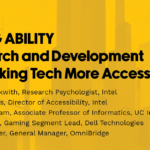
LARRY S. MCGRATH
Design Science Consulting, Inc.
[s2If is_user_logged_in()]
Download PDF
[/s2If]
[s2If current_user_can(access_s2member_level1)]
[/s2If]
Using eye tracking in ethnographic research poses numerous theoretical and practical challenges. How might devices originally intended to record individuals' vision of two-dimensional planes be useful in interpersonal contexts with dynamic visual interfaces? What would the technology reveal about collegial environments in which different levels of knowledge and expertise come together and inform decision-making processes? Why would pupil movement show us anything that conventional ethnographic methods could not? In this paper, I argue that these challenges are not intractable. When tailored to specific questions about perception, action, and collaboration, eye trackers can reveal behaviors that elude ethnographers' gaze. In so doing, the devices enrich the observational and interview-based methods already employed in ethnographic studies of workplace dynamics.
Hospitals are...


